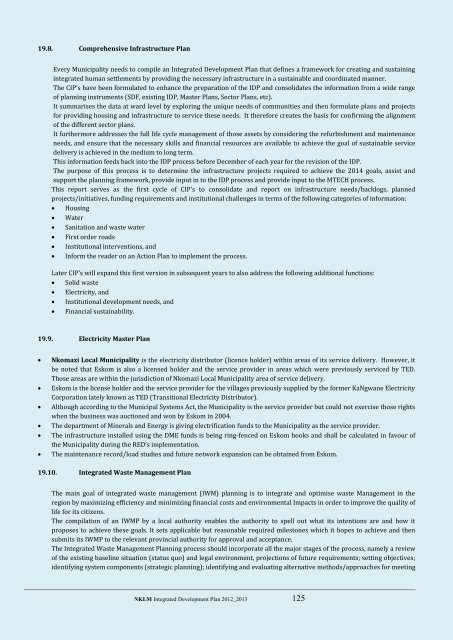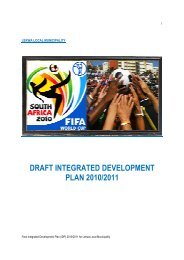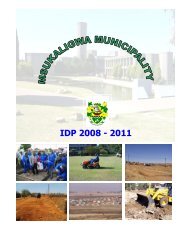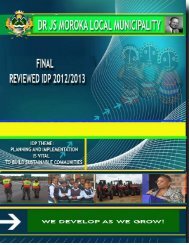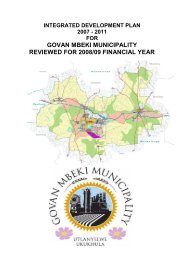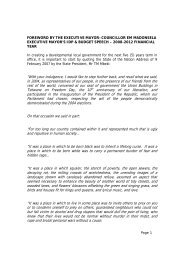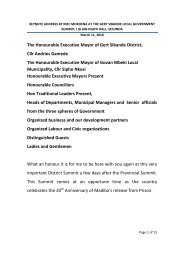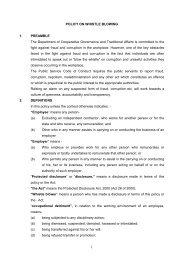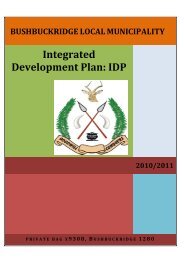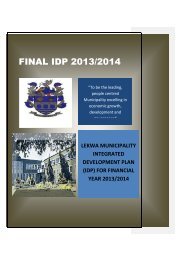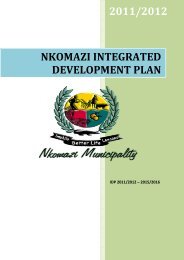Nkomazi Local Municipality 20 - Co-operative Governance and ...
Nkomazi Local Municipality 20 - Co-operative Governance and ...
Nkomazi Local Municipality 20 - Co-operative Governance and ...
- No tags were found...
Create successful ePaper yourself
Turn your PDF publications into a flip-book with our unique Google optimized e-Paper software.
19.8. <strong>Co</strong>mprehensive Infrastructure PlanEvery <strong>Municipality</strong> needs to compile an Integrated Development Plan that defines a framework for creating <strong>and</strong> sustainingintegrated human settlements by providing the necessary infrastructure in a sustainable <strong>and</strong> coordinated manner.The CIP’s have been formulated to enhance the preparation of the IDP <strong>and</strong> consolidates the information from a wide rangeof planning instruments (SDF, existing IDP, Master Plans, Sector Plans, etc).It summarises the data at ward level by exploring the unique needs of communities <strong>and</strong> then formulate plans <strong>and</strong> projectsfor providing housing <strong>and</strong> infrastructure to service these needs. It therefore creates the basis for confirming the alignmentof the different sector plans.It furthermore addresses the full life cycle management of those assets by considering the refurbishment <strong>and</strong> maintenanceneeds, <strong>and</strong> ensure that the necessary skills <strong>and</strong> financial resources are available to achieve the goal of sustainable servicedelivery is achieved in the medium to long term.This information feeds back into the IDP process before December of each year for the revision of the IDP.The purpose of this process is to determine the infrastructure projects required to achieve the <strong>20</strong>14 goals, assist <strong>and</strong>support the planning framework, provide input in to the IDP process <strong>and</strong> provide input to the MTECH process.This report serves as the first cycle of CIP’s to consolidate <strong>and</strong> report on infrastructure needs/backlogs, plannedprojects/initiatives, funding requirements <strong>and</strong> institutional challenges in terms of the following categories of information: Housing Water Sanitation <strong>and</strong> waste water First order roads Institutional interventions, <strong>and</strong> Inform the reader on an Action Plan to implement the process.Later CIP’s will exp<strong>and</strong> this first version in subsequent years to also address the following additional functions: Solid waste Electricity, <strong>and</strong> Institutional development needs, <strong>and</strong> Financial sustainability.19.9. Electricity Master Plan<strong>Nkomazi</strong> <strong>Local</strong> <strong>Municipality</strong> is the electricity distributor (licence holder) within areas of its service delivery. However, itbe noted that Eskom is also a licensed holder <strong>and</strong> the service provider in areas which were previously serviced by TED.Those areas are within the jurisdiction of <strong>Nkomazi</strong> <strong>Local</strong> <strong>Municipality</strong> area of service delivery.Eskom is the license holder <strong>and</strong> the service provider for the villages previously supplied by the former KaNgwane Electricity<strong>Co</strong>rporation lately known as TED (Transitional Electricity Distributor).Although according to the Municipal Systems Act, the <strong>Municipality</strong> is the service provider but could not exercise those rightswhen the business was auctioned <strong>and</strong> won by Eskom in <strong>20</strong>04.The department of Minerals <strong>and</strong> Energy is giving electrification funds to the <strong>Municipality</strong> as the service provider.The infrastructure installed using the DME funds is being ring-fenced on Eskom books <strong>and</strong> shall be calculated in favour ofthe <strong>Municipality</strong> during the RED’s implementation.The maintenance record/load studies <strong>and</strong> future network expansion can be obtained from Eskom.19.10. Integrated Waste Management PlanThe main goal of integrated waste management (IWM) planning is to integrate <strong>and</strong> optimise waste Management in theregion by maximizing efficiency <strong>and</strong> minimizing financial costs <strong>and</strong> environmental Impacts in order to improve the quality oflife for its citizens.The compilation of an IWMP by a local authority enables the authority to spell out what its intentions are <strong>and</strong> how itproposes to achieve these goals. It sets applicable but reasonable required milestones which it hopes to achieve <strong>and</strong> thensubmits its IWMP to the relevant provincial authority for approval <strong>and</strong> acceptance.The Integrated Waste Management Planning process should incorporate all the major stages of the process, namely a reviewof the existing baseline situation (status quo) <strong>and</strong> legal environment, projections of future requirements; setting objectives;identifying system components (strategic planning); identifying <strong>and</strong> evaluating alternative methods/approaches for meetingNKLM Integrated Development Plan <strong>20</strong>12_<strong>20</strong>13 125


